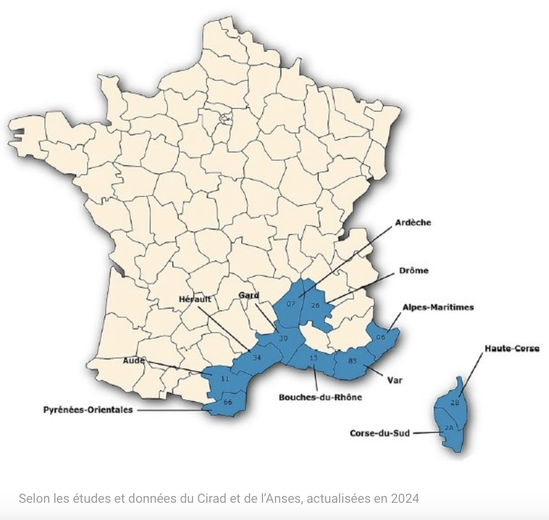“Giant ticks” invade the South of France: which departments in Occitanie are most affected by this dangerous pest ?
Nearly ten years after a first report in Occitania, the giant tick (Hyalomma marginatum), also called the “striped-legged” tick, continues to invade the scrubland of Languedoc Roussillon. Several departments are concerned.
Avoid grassy and meadow areas. Measuring 8 mm and armed with a spur (the “rostrum”), the giant tick is carried by two-tone legs decorated with whitish rings at the joints. Last October, for the first time in France, the Crimean-Congo Hemorrhagic Fever (CCHF) virus, fatal in some cases, was detected in specimens of this species. The mites had been taken from cows and horses in the Pyrénées-Orientales.
While this invasive species is endemic to Asia, North Africa, the Balkans, Spain and Italy, global warming has changed the situation. Now, the giant tick is proliferating in Languedoc-Roussillon, a region very popular with tourists during the summer.
11 departments concerned
The number of departments concerned has risen to 11, according to Santé publique France. Ardèche, Drôme, Haute-Corse, Corse du Sud, Aude, Hérault, Gard, Bouches-du-Rhône, Var, Alpes-Maritimes and Pyrénées-Orientales are now affected.

11 departments in the South of France are affected. Screenshot Santé Publique France
While no cases of transmission to humans have been documented, the disease, similar to Ebola, is potentially serious. "No human cases of transmission of Crimean-Congo hemorrhagic fever n’have been diagnosed in France to date. Nevertheless, the risk of contamination is now demonstrated because ticks infected by the virus are present in the south of France", writes Santé Publique France.< /p>
Even if the risk of transmission of Congo fever to humans is low, Congo Fever disease is not trivial. This infection can cause in humans "fever, chills, digestive problems and, in rare cases, serious forms with uncontrolled bleeding", according to Public Health France.
How to protect yourself?
Since this pest particularly likes dry areas of Mediterranean coastlines, the health authority reminds us to avoid grassy areas, such as meadows and hiking trails , in which the giant tick lives.
The most effective way to protect yourself from them is to wear closed shoes and clothing, preferably "in light colors in order to better spot the ticks on fabric. L’Anses advises in particular d'"put the pants in the socks".
If a tick comes into contact with your skin, remove it using a tick remover then disinfect the contact area.




